BMW M5

BMW M5

| BMW M5 | |
|---|---|
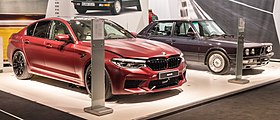 F90 M5 (left) and E28 M5 (right) | |
| Overview | |
| Manufacturer | BMW M GmbH |
| Production | 1984–present |
| Body and chassis | |
| Class | Executive car (E) |
| Layout |
|
| Related | BMW 5 Series BMW M6 |
| BMW M5 (E28) | |
 | |
| Overview | |
| Production | 1984–1988 |
| Body and chassis | |
| Body style | 4-door saloon/sedan |
| Related | BMW M1 |
| Powertrain | |
| Engine |
|
| Transmission | 5-speed manual |
| Dimensions | |
| Wheelbase | 2,624 mm (103.3 in) |
| Length | 4,620–4,800 mm (181.9–189.0 in) |
| Width | 1,699 mm (66.9 in) |
| Height | 1,415 mm (55.7 in) |
| Curb weight | 1,410 kg (3,109 lb)[6] |
| BMW M5 (E34) | |
| Overview | |
| Production | 1988–1995 |
| Body and chassis | |
| Body style |
|
| Powertrain | |
| Engine | 3.5–3.6 L S38 I6 |
| Transmission |
|
| Dimensions | |
| Wheelbase | 2,761 mm (108.7 in) |
| Length | 4,720 mm (185.8 in) |
| Width | 1,750 mm (68.9 in) |
| Height | 1,392 mm (54.8 in) |
| Curb weight | 1,745 kg (3,847 lb)[15] |
| BMW M5 (E39) | |
 | |
| Overview | |
| Production | 1998–2003 |
| Body and chassis | |
| Body style | 4-door saloon/sedan |
| Powertrain | |
| Engine | 4.9 L S62 V8 |
| Transmission | 6-speed manual |
| Dimensions | |
| Wheelbase | 2,830 mm (111.4 in) |
| Length | 4,783 mm (188.3 in) |
| Width | 1,801 mm (70.9 in) |
| Height | 1,412 mm (55.6 in) |
| Curb weight | 1,795 kg (3,957 lb)[33] |
| BMW M5 (E60) | |
 | |
| Overview | |
| Production | 2005–2010 |
| Body and chassis | |
| Body style | 4-door saloon/sedan 5-door estate/wagon |
| Powertrain | |
| Engine | 5.0 L S85 V10 |
| Transmission |
|
| Dimensions | |
| Wheelbase | 2,890 mm (113.8 in) |
| Length | 4,855–4,864 mm (191.1–191.5 in) |
| Width | 1,846 mm (72.7 in) |
| Height |
|
| Curb weight | |
| BMW M5 (F10) | |
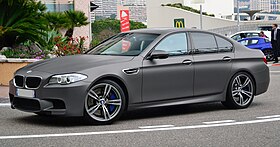 | |
| Overview | |
| Production | 2011–2016 |
| Body and chassis | |
| Body style | 4-door saloon/sedan |
| Powertrain | |
| Engine | 4.4 L twin-turbocharged S63 V8 |
| Transmission |
|
| Dimensions | |
| Wheelbase | 2,964 mm (116.7 in) |
| Length | 4,910 mm (193.3 in) |
| Width | 1,891 mm (74.4 in) |
| Height | 1,451 mm (57.1 in) |
| Curb weight | 1,990 kg (4,387 lb)[69] |
| BMW M5 (F90) | |
 | |
| Overview | |
| Production | 2017–present[82] |
| Body and chassis | |
| Body style | 4-door sedan/saloon |
| Layout | Front-engine, all-wheel-drive |
| Powertrain | |
| Engine | 4.4 L twin-turbocharged S63 V8 |
| Transmission | 8-speed automatic |
| Dimensions | |
| Wheelbase | 2,982 mm (117.4 in)[83] |
| Length | 4,965 mm (195.47 in)[83] |
| Width | 1,903 mm (74.92 in)[83] |
| Height | 1,473 mm (57.99 in)[83] |
| Curb weight | 1,855 kg (4,090 lb)[84] |
The BMW M5 is a high performance variant of the BMW 5 Series marketed under the BMW M sub-brand. It is considered an iconic vehicle in the sports sedan category.[1][2] The majority of M5's have been produced in the sedan (saloon) body style, but in some countries the M5 was also available as a wagon (estate) from 1992–1995 and 2006–2010.[3][4]
The first M5 model was hand-built in 1985 on the E28 535i chassis with a modified engine from the M1 that made it the fastest production sedan at the time.[5] M5 models have been produced for every generation of the 5 Series since 1985.
| BMW M5 | |
|---|---|
 F90 M5 (left) and E28 M5 (right) | |
| Overview | |
| Manufacturer | BMW M GmbH |
| Production | 1984–present |
| Body and chassis | |
| Class | Executive car (E) |
| Layout |
|
| Related | BMW 5 Series BMW M6 |
| BMW M5 (E28) | |
 | |
| Overview | |
| Production | 1984–1988 |
| Body and chassis | |
| Body style | 4-door saloon/sedan |
| Related | BMW M1 |
| Powertrain | |
| Engine |
|
| Transmission | 5-speed manual |
| Dimensions | |
| Wheelbase | 2,624 mm (103.3 in) |
| Length | 4,620–4,800 mm (181.9–189.0 in) |
| Width | 1,699 mm (66.9 in) |
| Height | 1,415 mm (55.7 in) |
| Curb weight | 1,410 kg (3,109 lb)[6] |
| BMW M5 (E34) | |
| Overview | |
| Production | 1988–1995 |
| Body and chassis | |
| Body style |
|
| Powertrain | |
| Engine | 3.5–3.6 L S38 I6 |
| Transmission |
|
| Dimensions | |
| Wheelbase | 2,761 mm (108.7 in) |
| Length | 4,720 mm (185.8 in) |
| Width | 1,750 mm (68.9 in) |
| Height | 1,392 mm (54.8 in) |
| Curb weight | 1,745 kg (3,847 lb)[15] |
| BMW M5 (E39) | |
 | |
| Overview | |
| Production | 1998–2003 |
| Body and chassis | |
| Body style | 4-door saloon/sedan |
| Powertrain | |
| Engine | 4.9 L S62 V8 |
| Transmission | 6-speed manual |
| Dimensions | |
| Wheelbase | 2,830 mm (111.4 in) |
| Length | 4,783 mm (188.3 in) |
| Width | 1,801 mm (70.9 in) |
| Height | 1,412 mm (55.6 in) |
| Curb weight | 1,795 kg (3,957 lb)[33] |
| BMW M5 (E60) | |
 | |
| Overview | |
| Production | 2005–2010 |
| Body and chassis | |
| Body style | 4-door saloon/sedan 5-door estate/wagon |
| Powertrain | |
| Engine | 5.0 L S85 V10 |
| Transmission |
|
| Dimensions | |
| Wheelbase | 2,890 mm (113.8 in) |
| Length | 4,855–4,864 mm (191.1–191.5 in) |
| Width | 1,846 mm (72.7 in) |
| Height |
|
| Curb weight | |
| BMW M5 (F10) | |
 | |
| Overview | |
| Production | 2011–2016 |
| Body and chassis | |
| Body style | 4-door saloon/sedan |
| Powertrain | |
| Engine | 4.4 L twin-turbocharged S63 V8 |
| Transmission |
|
| Dimensions | |
| Wheelbase | 2,964 mm (116.7 in) |
| Length | 4,910 mm (193.3 in) |
| Width | 1,891 mm (74.4 in) |
| Height | 1,451 mm (57.1 in) |
| Curb weight | 1,990 kg (4,387 lb)[69] |
| BMW M5 (F90) | |
 | |
| Overview | |
| Production | 2017–present[82] |
| Body and chassis | |
| Body style | 4-door sedan/saloon |
| Layout | Front-engine, all-wheel-drive |
| Powertrain | |
| Engine | 4.4 L twin-turbocharged S63 V8 |
| Transmission | 8-speed automatic |
| Dimensions | |
| Wheelbase | 2,982 mm (117.4 in)[83] |
| Length | 4,965 mm (195.47 in)[83] |
| Width | 1,903 mm (74.92 in)[83] |
| Height | 1,473 mm (57.99 in)[83] |
| Curb weight | 1,855 kg (4,090 lb)[84] |
E28 M5 (1984–1988)

BMW M88/3 straight-six engine
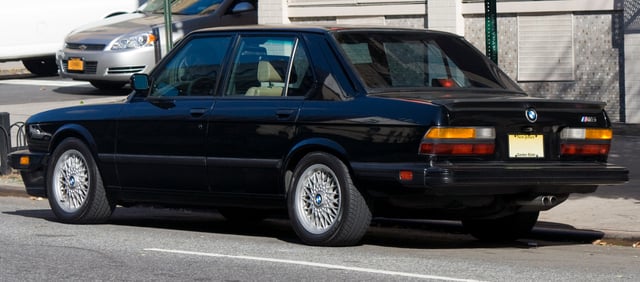
Rear 3/4 view (US-spec bumpers)
The first BMW M5, based on the E28 5 Series, was manufactured from October 1984 to June 1988.[7] It made its debut at the Amsterdam Motor Show in February 1985.[8] It was based on the 535i chassis with various mechanical changes, most notably the M88/3 engine (shared with the E24 M635CSi grand tourer coupe) which was an updated version of the engine used in the M1 sports car.[7] At its launch, the E28 M5 was the fastest production sedan in the world.[5]
The official markets for the E28 M5 were Europe, Great Britain, the United States, Canada and South Africa. The European and South African cars utilised the M88/3 engine which has a power output of 210 kW (282 hp).[9]
Cars sold in the United States and Canada used a detuned version of the M88/3 called the S38B35, which was equipped with a catalytic converter and has a power output of 191 kW (256 hp).[10] Due to an extended production run that exceeded BMW's original forecast of production volumes, a class action lawsuit was launched by owners in the United States. The results of this class action was that owners were given a voucher for US$4,000 in 1993.[11] Production of North American specification M5 commenced in November 1986 and ended in November 1987.[12]
Aside from 96 cars which were assembled in kit form at BMW's Plant in Rosslyn, South Africa, all cars were assembled by hand in Germany. Assembly took place at BMW Motorsport's plant in Preussenstrasse in Munich prior to the 1986 factory summer vacation. Thereafter, the M5 production was moved to Daimlerstrasse in Garching where the remainder were built.[12] With a total production of 2,241 units,[7][12] the E28 M5 remains among the rarest regular production BMW Motorsport cars – after the M1 (456 units), M5 (E34) Touring (891 units)[13] and the 850CSi (1,510 units).[14]
E34 M5 (1988–1995)

Wagon- rear 3/4 view
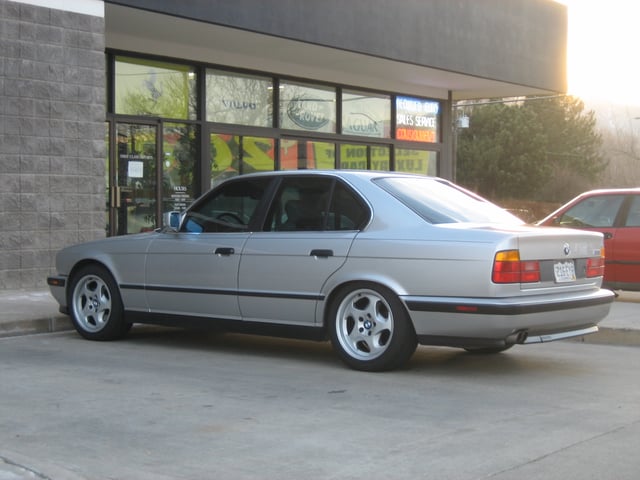
Sedan- rear 3/4 view
The E34 generation of the M5 was produced from September 1988 to August 1995. Powered by the S38 straight-6 engine, an evolution of the previous generation's straight-6, it was initially produced in a sedan body style, with a LHD Touring (estate/wagon) version following in 1992.[16]
Production of M5 models began with the painted bodyshell of an E34 5 Series at the BMW Dingolfing plant.[17] The shells were then transported to BMW M GmbH in Garching, where the car was assembled by hand over a period of two weeks.[18][19] Only the South African M5 was entirely assembled at the Rosslyn, South Africa assembly plant from complete knock-down kits supplied from Garching, Germany. The M5 Touring, which was BMW M Division's first wagon as well as the last hand-built M car, saw 891 units produced. Total production of the E34 M5 was 12,254 units.[17]
Cosmetic changes to the exterior from the standard E34 included unique front and rear bumpers and side rocker panels, contributing to a drag coefficient of 0.32 (from 0.30),[20] and interior updates included a unique gearshift surround and rear headrests.
The second-generation M5 was introduced with the S38B36 engine, which generated 232 kW (311 hp) at 6,900 rpm and 360 N⋅m (266 lb⋅ft) of torque at 4,750 rpm,[20] touting a factory 0-97 km/h (60 mph) acceleration figure of 6.3 seconds.[20] Top speed was electronically limited to 250 kilometres per hour (160 mph).[21]
Updates
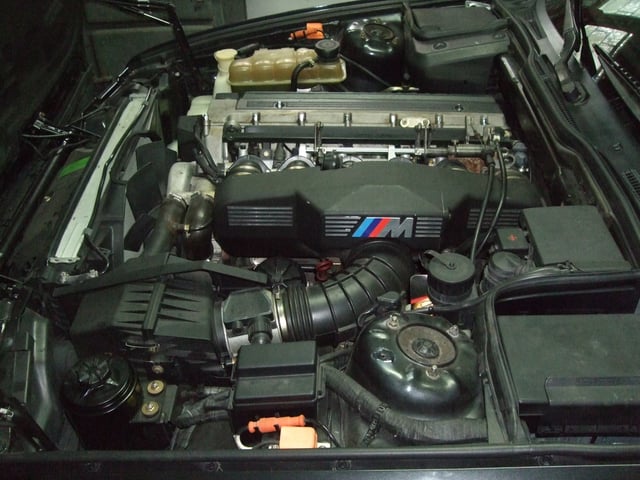
BMW S38 straight-six engine (3.8 L version)
In late 1991 (1992 model year), the engine was upgraded to the 3.8-litre S38B38,[22] with exception to North America and South Africa, which continued with the 3.6-litre engine due to emission laws. Power increased to 250 kW (335 hp),[23] leading to a factory 0-97 km/h (60 mph) acceleration time of 5.9 seconds, and the ignition changed to a distributor-less system with each cylinder having an individual coil. BMW also used a dual-mass flywheel in place of the single in the 3.6-litre version for a smoother idle and throttle input at the expense of response. The standard self-leveling suspension (SLS) system, which maintained a constant ride height in the rear, was replaced with Electronic Damper Control (EDCIII+), an electronically controlled and hydraulically regulated system that can switch between comfort "P" setting and a more track-oriented "S" setting.
A 6-speed Getrag 420G manual transmission was introduced in 1994, which added an overdriven top gear.[24]
M-System wheels
The M5 came with an unusual wheel design. From 1988–1992 the M5 featured the three-piece Style 20 "M-System" wheels, which consisted of directional bolted-on wheel covers and a fin assembly in front of the black, 5-spoke forged aluminum wheel. The purpose of the M-System cover was to divert heat from the brake assembly to increase cooling.
In 1992 BMW changed the design to the "M-System II" (nicknamed "throwing stars") which improved brake cooling from the combination of the larger openings and fins placed in the driving direction.[25]
In May 1994, the M5 switched to 18-inch Style 37 "M Parallel" wheels that did away with the finned cover entirely.[17]
Special editions
There were four special editions of the E34 M5. The Cecotto, Winkelhock and 20 Jahre editions which were offered as LHD Euro specification models while the RHD UK Limited edition was only sold in the United Kingdom.[17]
In 1991, BMW asked two race drivers to design their "ideal" version of the E34 M5. The Cecotto Edition M5, named after Johnny Cecotto, featured severy luxury items fitted, including Nappa leather for the steering wheel and heated seats. A total of 22 Cecotto E34 M5s were produced with options of having either Lagoon Green metallic (code number 266) and Mauritius Blue metallic paint (code number 287) and Light Parchment or Light Silvergrey upholstery for the interior.[17]
The other M5 special edition dedicated to a race driver was the Winkelhock Edition, named after touring car driver Joachim Winkelhock. The resulting car was a lightweight M5 stripped of some amenities. The Winkelhock Edition features a smaller battery, the reduced US-spec 81-litre fuel tank, reduced sound deadening, and deletion of non-essential items such as rear headrests, vanity mirrors, rear window switches and foglights. The Recaro front seat design, suede-covered 385mm M-Technic II steering wheel, shift knob and parking brake handle, and red seatbelts were similar to those on the BMW E30 M3 Sport Evolution. A total of 51 Winkelhock E34 M5s were produced with the options of having Jet Black (code number 668) with contrasting lower body panels in Sterling Silver metallic paint (code number 244).[17]
The 20 Jahre Motorsport Edition was built to celebrate BMW Motorsport's 20th anniversary in 1992. Twenty cars were produced, all Euro-spec 3.8-litre models. Offered only in Mugello Red (code numher 274), the anniversary edition had a number of aesthetic trim upgrades such as carbon fiber dash panels, red seat belts embroidered with "BMW Motorsport," and M-Technic rear-view mirrors. Unique seat center & door trim fabric were matched with Alcantara, which was also used on the steering wheel, shift lever & parking brake lever.[26]
The UK Limited Edition was produced from March to June 1995, to commemorate the end of right-hand drive E34 M5 production. Fifty cars were produced, in one of two color and trim combinations: Rosso Red metallic (code number 369) with a Champagne extended leather interior and natural poplar wood trim (15 built) or Orinoco metallic (code number 406) with a Bicolour Petrol and Mint extended leather interior and graphite bird's-eye maple wood trim (35 built). Each E34 M5 Limited Edition is equipped with the three-spoke sport steering wheel, Shadowline trim, power sunroof, power front seats, headlight washers and manual air conditioning. A numbered plaque appears on the center console.[17][27]
Additionally, 20 M5 Touring Elekta models were assembled for distribution in Italy in 1995. These were finished in either Sterling Silver over Marine Blue leather, or British Racing Green over Tobacco leather and featured extended leather interior as well as unique, numbered shift knobs. It is debated as to whether or not these cars constitute a true special edition as they were ordered directly by a group of Italian BMW dealers.[17]
BMW developed a prototype convertible model, which featured an electric folding cloth roof and a steeper raked windshield than a standard M5.[28] Steel reinforcements were added under both side valance panels to reduce body flex, and curb weight was approximately 100 kg (220 lb) more than the sedan model. The prototype was never given the green light for production due to financial considerations.[17]
Motorsport
E39 M5 (1998–2003)

BMW S62 V8 engine
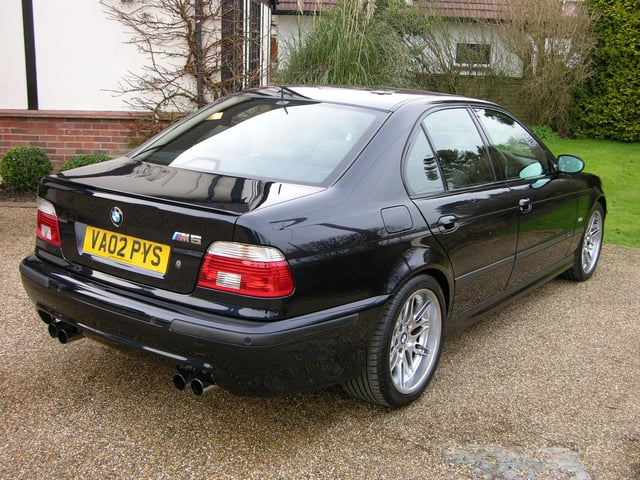
Rear 3/4 view
Introduced in 1998 at the Geneva Motor Show, the E39 generation of the M5 was the first M5 to use a V8 engine, resulting in an increase in power output to 294 kW (394 hp).[34] It is also the first M5 to use aluminium front suspension components and a multi-link rear suspension. Production began in October 1998.
Production totalled to 20,482 cars from 1999 to 2003. Unlike its predecessors, the M5 was produced on the same assembly line as the regular 5 Series models at the Dingolfing factory in Germany.
The official performance figures are 0–97 km/h (60 mph) acceleration time of 4.8 seconds and an electronically limited top speed of 250 km/h (155 mph).[35][36] In testing, an unrestricted M5 reached a top speed in excess of 300 km/h (186 mph).[37] The E39 M5 recorded a Nurburgring lap time of 8:20[35]
The M5 received the September 2000 facelift (for the 2001 model year) at the same time as the standard E39 models.[38] Changes included halogen "corona rings" in headlights (often called "Angel Eyes"), LED tail-lights and various interior upgrades. The mechanical specification was unchanged. For the subsequent two model years, changes were limited to the addition of new exterior colours (from September 2001) and the upgrade to a DVD-based navigation system (from September 2002).[38]
Production of a "Touring" (wagon/estate) E39 M5 model was evaluated by BMW, and at least one prototype was developed (in Titanium Silver with a Black Exclusive leather interior). However the Touring did not reach production, due to financial considerations.[39]
Engine
The E39 M5 is powered by the BMW S62 V8 engine, which generates a power output of 294 kW (394 hp) at 6,600 rpm and 500 N⋅m (369 lb⋅ft) of torque at 3,800 rpm.[33][40] The S62 engine has electronically-actuated individual throttle bodies, an aluminium block and heads, variable valve timing (double-VANOS), and a semi-dry sump oil system.
Drivetrain
The transmission is the Getrag 420G six-speed manual, as used in the E39 540i but with an upgraded clutch due to the increased torque. The differential uses a shorter 3.15:1 ratio, and is a limited slip differential with 25% maximum locking.
Chassis
The E39 M5 uses aluminium-intensive MacPherson strut front suspension and multi-link rear suspension, as per the other V8 models of the E39 5 Series range. However, several changes were made by BMW M. Reduced spring height, 23 mm (0.9 in) lower. A specific shock valving, thicker front and rear anti-roll bars, polyurethane auxiliary springs, and steel balljoints.
Although the six-cylinder E39 models use rack-and-pinion steering, the M5 (and other V8 models) retains the recirculating ball steering system, as used by previous generations of the M5. A quicker steering ratio of 14.7 was used, compared with 17.9 for other V8 models.[38] It featured a Servotronic vehicle-speed-sensitive power assist which provides two levels of resistance controlled via console mounted Sport button. The Sport button also adjusted the electronic throttle butterflies for more sensitive response.[41]
Brake discs (rotors) are a "floating" two-piece design (except for U.S and Canada models), for reduced risk of cone distortion. Their lower unsprung weight improves ride quality and traction on bumpy surfaces as well. The front discs are 345 mm (13.58 in) in diameter and the rear discs are 328 mm (12.91 in) in diameter.[33]
E60/E61 M5 (2005–2010)

Wagon- front 1/4 view

Sedan- rear 3/4 view
The E60 M5 was introduced in 2005, with a V10 engine and 7-speed transmission linking the car with the BMW Sauber Formula One program.[43][44] The E60 M5 was the world's first production sedan to use a V10 petrol engine. This generation of the M5 was also built in the E61 Touring (wagon) body style, which was only sold in Europe. The E63/E64 M6 coupé and convertible are based on a shortened version of the M5 chassis and largely use the same mechanical components.
The official 0 to 100 km/h (62 mph) acceleration figure is 4.7 seconds for the sedan,[45] however magazine tests have recorded figures down to 4.1 seconds.[46] The E60 M5 was the fastest 4-door sedan available at the time of its introduction.[47] Top speed is electronically restricted to 250 km/h (155 mph)[45] but could be raised to 305 km/h (190 mph) with the optional M-driver's package.[48] The M5 has recorded a Nürburgring lap time of 8:13.[49][50]
Upgrades over regular 5 Series models include a wider track, unique body panels, a colourful heads up display featuring navigation, control messages, speed, rpm and gear selection information, automated seat side bolsters, heated/ventilated seats and power rear curtain. The larger, flared front guards on either side also featured cooling vents, reminiscent of the 1970s BMW CSL. The wheels were of a 19-inch diameter and the car has quad exhaust pipes at the rear.
During its five-year production run, 20,589 units were built composing of 19,564 sedans and 1,025 wagons. The biggest market was the United States with 8,800 cars (all sedans), followed by Great Britain and Ireland with 1,776 cars and Germany with 1,647 cars.[51]
The M5 model was designed by Karl John Elmitt[52] and produced at the BMW Plant Dingolfing in Germany.
Engine
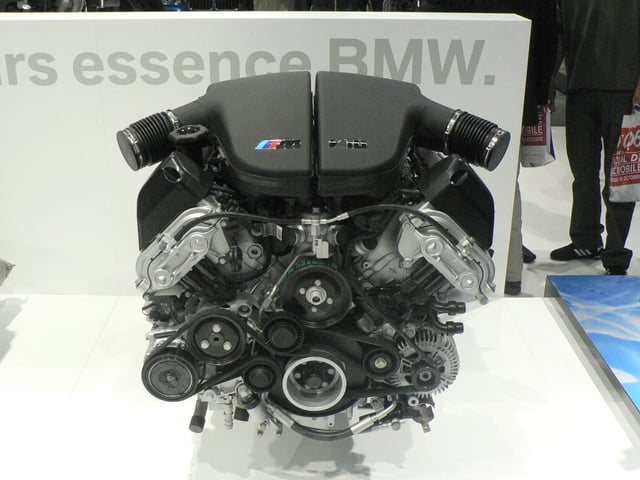
BMW S85 V10 engine
There are three driver-selectable engine modes: P400, P500 and P500 S. P400, the default start-up mode, limits the engine to 294 kW (394 hp). P500 increases power to the full 373 kW (500 hp). The P500 S mode keeps the engine rather same power output as the P500 mode but adds a more sensitive throttle response.[54]
Transmission
The M5 uses the "SMG III" 7-speed single-clutch Electrohydraulic manual transmission, that performs gear shift in 65-250 milliseconds.[55]
The SMG III includes launch control, a hill holder, shift-lock avoidance (by briefly disengaging the clutch during downshifts) and an automatic shift mode.[56] However, many reviews have observed the automatic mode of the transmission at low or frequent stop start speeds as being less smooth than that of a conventional automatic transmission.[57][58][59][60][61][62]
In North America, a conventional six-speed manual transmission was announced in October 2006.[63] The SMG III remained the default transmission in North America, while the manual was available as a no cost option.[64][65] The six-speed manual M5 was marginally slower in certain tests, as the dynamic stability control could not be disengaged unlike the SMG version[66][67] (however this was later made possible and a retrofit was released for earlier cars).[68] In North America, the launch control for SMG transmissions is set at 1,500 rpm, instead of the 4,000 rpm used in other regions.
F10 M5 (2011–2016)
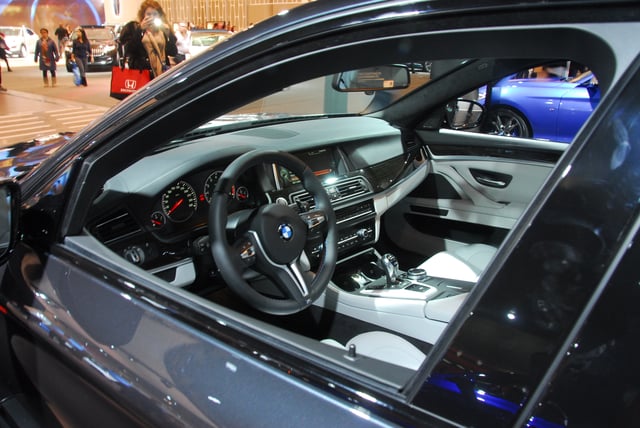
Interior
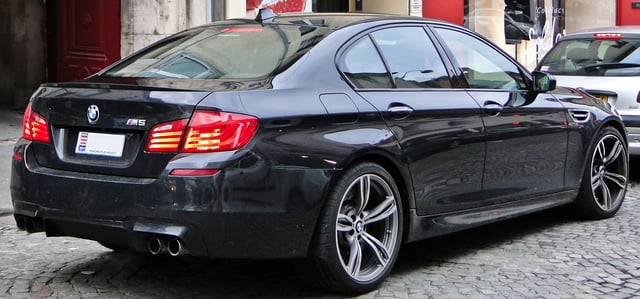
Rear 3/4 view
The F10 M5 was unveiled at the 2011 Frankfurt Motor Show and sales began in November 2011.[70] It is powered by a twin-turbocharged V8 engine, making it the first turbocharged M5 model. The gearbox in most markets is a 7-speed dual-clutch transmission marking the first time an M5 has used a dual-clutch transmission. A traditional 6-speed manual transmission was also available in the United States.[71]
The BMW S63B44TÜ engine is an upgraded version of the 4.4 L (269 cu in) twin-turbocharged V8 first introduced in the 2010 E70 X5 M, generating a maximum power output of 412 kW (553 hp) at 6,000–7,000 rpm and 680 N⋅m (502 lb⋅ft) at 1,500–5,750 rpm.[72] This results in an official 0 to 100 km/h (62 mph) acceleration time of 4.4 seconds and top speed (with the optional M Driver's Package fitted) of 305 km/h (190 mph).[73] The F10 M5 has a reported Nürburgring lap time of 7:55.[74]
An Active M-Differential provides torque vectoring between the rear wheels, which are 19-inches in standard trim. Optional 20-inch wheels are fitted with 265/35/20 front and 295/30/20 rear Michelin Pilot Super Sport tyres. Standard brakes are 6-piston front calipers[75] with carbon ceramic brakes optional. The F10 M5 weighs 1,945 kg (4,288 lb), which is 90 kg (198 lb) more than its predecessor. The F10 M5 was praised for its improved gearbox and fuel economy; however, the engine sound, steering feel and increased weight were criticised.[76][77]
The M5 was produced alongside regular 5 Series models at the BMW Dingolfing Plant in Germany. Production ended in October 2016.[78]
From 2014, the BMW M5 Competition Package was introduced. The Competition Package increases peak engine power to 423 kW (567 hp) and has a revised suspension setup (bushings, springs, dampers, anti-roll bars) which lowers the car 10 mm (0.4 in).[79] In 2015, the power output of the M5's Competition Package was raised to 441 kW (591 hp) and 700 N⋅m (516 lb⋅ft)[80]
Special editions
To celebrate BMW M5 30th anniversary in 2015, BMW had built 300 special edition models, named "30 Jahre BMW M5".[81] All 300 cars came in BMW special edition paint in the Individual colour shade called the Frozen Dark Silver metallic. On the interior, “30 Jahre M5” is embroidered on the front door sill finishers and the seat backrests, and plaque bearing “30 Jahre M5” and “1/300” inscriptions is placed on the dashboard.
F90 M5 (2017–present)

BMW S63 twin-turbo V8 engine

Rear 3/4 view
The F90 M5 is based on the G30 5 Series and uses an all-wheel drive ("xDrive") powertrain, being the first time that an M5 has not been rear-wheel drive.[85][86] However the all-wheel drive system is biased towards the rear wheels and be configured to send power to the rear wheels only (if the electronic stability control is disabled).[87]
The F90 M5 accelerates from a standstill to 100 km/h (62 mph) in 3.4 seconds,[91] and to 200 km/h (124 mph) in 11.1 seconds.[87] The top speed is limited to 250 km/h (155 mph), and the delimited top speed is 305 km/h (190 mph) with the optional M Driver's Package.[87] Despite the added weight of the all-wheel drive components, the weight of the F90 M5 is approximately 40 kg (88 lb) lower than the previous generation M5.[92]
In December 2017, the F90 M5 set the Guinness World Records for "Longest continuous vehicle drift" and "Longest twin vehicle drift (water assisted)" on a wet skidpad, with distances of 374 km (232 mi) and 144 km (89 mi) respectively.[93]
In May 2018, the M5 Competition model was announced. The M5 Competition retains the same powertrain as the standard M5, but total power output has been increased to 460 kW (617 hp) at 6,000 rpm. Torque remains the same at 750 N⋅m (553 lb⋅ft) between 1,800–5,800 rpm. 0–100 km/h (0–62 mph) acceleration time has also improved and now stands at 3.3 seconds, 0.1 seconds quicker than the standard car along with 0–200 km/h (0–124 mph) acceleration time improving to 10.8 seconds, 0.3 seconds quicker than the standard car. Other changes include a revised suspension, lowering by 7 mm (0.3 in), the "Frozen Dark Silver" paint option, revised wheels and a redesigned exhaust system.[94]
Engine and transmission
The engine is an evolution of the S63 from the previous generation.[95] With a power output of 441 kW (591 hp) the new M5 has the same power as the limited edition "Competition Package" and "30 Jahre M5" models of the previous generation, while the torque has been raised to 750 N⋅m (553 lb⋅ft), 70 N⋅m (52 lb⋅ft) more than the previous M5.
The transmission is the eight-speed ZF 8HP automatic transmission.[96] The F90 is the first M5 to use a torque converter automatic transmission (compared with the previous generation's dual-clutch transmission), which BMW states was chosen for its durability and because shift times are not significantly slower than a dual-clutch transmission.[97]
See also
BMW 5 Series
BMW M3
BMW M6